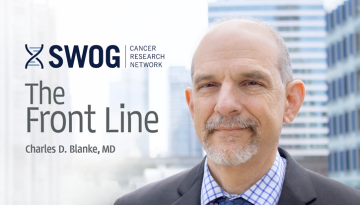Pitching the PAC for Maximum ImPACt
Our patient advocate committee (PAC) continues to top itself. Over the past year or so, it's created and operationalized a new model for bringing advocate insight into the early stages of clinical trial concept development. The approach is complementary to (and probably synergistic with) the disease- or committee-aligned advocate model we've been using so successfully. And our study teams are queuing up to benefit from it.
In early 2024, I devoted a Front Line to introducing this new approach, which was born of a brainstorming session PAC co-chairs Barbara Segarra-Vazquez, DHSc, and Anne Marie Mercurio had with Dr. Dawn Hershman, SWOG group co-chair-elect. The approach was tentatively titled “Pitch the PAC.” The approach, and name, caught on, and a year later, we can declare the initiative an unqualified success!
Pitch the PAC (snappy alliteration is so hard to resist) is now a key venue our study teams are using to solicit broad-spectrum advocate input during trial concept development.
Starting with the first such review in late 2023 (that concept is now in protocol development as S2424CD), the PAC has completed 14 Pitch the PAC sessions, reviewing proposals from nine of our research committees.
On average, about 12 advocates contribute at each session, though that number has ranged as high as 20.
This breadth of experience – pooling insights from advocates across multiple disease areas – is a primary strength of this approach. The sessions also bring our community advocates to the table, providing key input that can help study teams reach wider groups of potential participants and maximize enrollment.
The sessions can benefit advocates as well, exposing them to a much wider range of protocols, each with its own design challenges and solutions, than they would otherwise engage with.
Over the past year, roughly one-half of our trial concepts have undergone a Pitch the PAC review during their embryonic stage, typically shortly before or after executive “triage” review.
The one-hour session is designed to help a study team ensure they consider the full range of potential participant concerns as early as possible. Does the trial include the right population? Does it pose unacceptable burdens for participants? What issues can be addressed now that might promote easier and faster enrollment later and reduce trial drop-out rates?
A study team takes 15 minutes to present the trial’s goals and its potential impact on the affected patient population, highlighting the proposed inclusion and exclusion criteria and details of what will be expected of participants (visits, tests, questionnaires, etc.). The rest of the hour is devoted to open discussion of the concept. The study team is then asked to complete a brief post-session survey.
Based, in part, on feedback from that survey, the PAC has worked to streamline the experience for study teams (interested investigators can submit a request online) and to standardize the process to make it easier to capture data we can use to measure the program’s impact.
What impact have we seen? Here are a few of the steps study teams have reported taking in response to a Pitch the PAC review:
- changing the study aims
- expanding eligibility criteria
- refining how the study collects and interprets patient-reported outcomes
- reconsidering how to successfully present the study to potential participants as an alternative to the standard of care
- incorporating additional patient-friendly materials to meet participant needs and address likely questions
- revising the informed consent draft based on advocate-identified challenges
Our PAC reviewed 10 concepts in this manner in 2024. Although they’ve already reviewed two in February(!), as a rule PAC co-chairs try to limit these sessions to no more than one per month, keeping in mind that our patient advocates serve on a volunteer basis, and most already devote significant time to their dedicated working committee.
Looking to make that concept you’re working up more patient friendly and appropriate (you probably should be)? The Pitch the PAC tag line sort of explains it all:
Your ideas, our insights … maximum impact
How might the PAC help make your ideas and concepts even stronger?
An excellent question, well worth answering.
A note to SWOG’s members:
These are uncertain and stressful times in the biomedical research community, especially as we don’t truly know the extent to which recent and future executive orders will affect us. I don’t want to offer a merely theoretical and reactive action plan, but I am very sympathetic to the stress our researchers and institutions are under. For now I can assure members we will continue our important work, we will continue to design and conduct our ground-breaking clinical trials, and we will continue to remain true to our shared mission.
For some specific steps we can take, please see the American Association for Cancer Research’s (AACR’s) Call to Action. It’s time we were all research advocates.
Other Recent Stories



